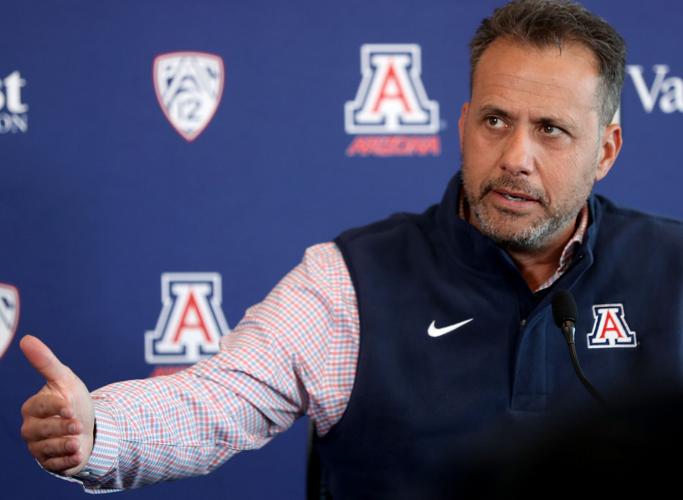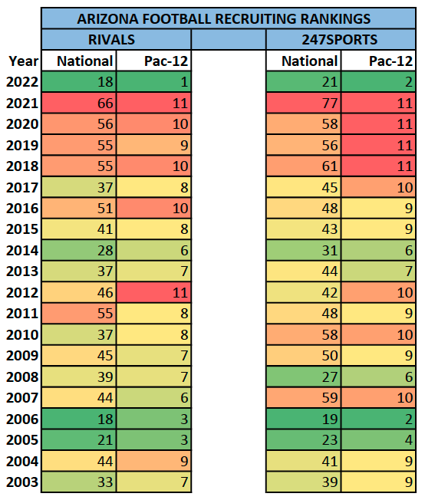From one win to No. 1.
How did the worst team in the Pac-12 produce what might be the best recruiting class in the conference?
There’s no grand mystery behind Arizona’s success on the trail under Jedd Fisch and his staff. He came to Tucson with a vision. He implemented it. He got his staff to buy in. They attacked recruiting with a dogged determination. They also benefited from a bit of good fortune.
Whatever the reasons, the results are astonishing: The Wildcats have the No. 1-ranked recruiting class in the Pac-12 heading into the weekend, according to Rivals.com. They’re ranked second by 247Sports.com.
“It is really amazing,” said Adam Gorney, the national recruiting director for Rivals. “It’s a testament to Jedd Fisch and his staff developing relationships, being super active and still selling the dream even after a first year that didn’t go very well.
“Arizona did the best job that could possibly be done off a 1-11 season.”
In Year 1 under Fisch, the Wildcats posted their worst full-season record since 1957. Arizona followed it with its best recruiting class ... ever?
With National Signing Day still to come next week — but most programs having filled most of their spots — Arizona sits at No. 18 nationally, per Rivals. That matches the Wildcats’ highest ranking over the past 20 years; they were also 18th in 2006.
In the interim — a span of 15 recruiting cycles — Arizona ranked in the top 30 only once (28th in 2014). The Wildcats’ average ranking over that span was 46th — with a low of 66 for the 2021 class (most of which signed before Fisch arrived). They never finished higher than sixth in the Pac-12.

Tetairoa McMillan answers questions from reporters Friday. McMillan is Rivals' No. 2 wide receiver in the country, and was the top recruit in the Wildcats' stellar class.
247Sports has Arizona 21st in the country, also its highest mark since 2006 (19th), and second in the Pac-12. The recruiting outlet had the Wildcats in the top 30 one time (27th in 2008) over the next 15 years — cratering at 77th for the class of ’21. Arizona’s average national ranking over that span was 50th. Again, the Wildcats never placed higher than sixth in the conference.
“At the risk of being hyperbolic, it’s as remarkable a recruiting job as I’ve seen on the West Coast,” said Brandon Huffman, the national recruiting editor for 247Sports. “Arizona football recruiting was dead. There was no buzz, no momentum.”
Then Fisch arrived.
“We have a sign in our building that says, ‘No one rises to low expectations,’ ” he said Friday while introducing the players who enrolled this month. “So we tried to make them as high as we possibly could, and we’re really excited about the ... domino effect. They just kept coming.
“Toward the end, you’re bringing in guys that were committed to top programs — that had offers from every program in the country.”
From the top down
One of Fisch’s first initiatives was to ensure he had the resources to expand the football program’s “front office.” He wanted to model it after an NFL personnel department. The current online directory shows 34 staff members under Fisch — and that doesn’t include the strength-and-conditioning coaches. It was a necessary move to keep up with the competition. It’s also a far cry from the skeleton staffs of yesteryear.
Fisch then put his team to work to improve and build relationships with high school programs and prospects in Arizona and beyond. He didn’t lead the charge from behind a desk.
“That trickles down from the top,” Huffman said of the UA staff’s work ethic on the recruiting trail. “Jedd was at UCLA and Michigan, where Jim Mora and Jim Harbaugh both did a great job of taking an active role. That’s what’s been modeled to him.
“It’s one thing to say you want to get out there. It’s another thing to get out there.”
“Jedd walked into this job with a very clear plan,” Pac-12 Networks analyst Yogi Roth said. “And not one he developed in real time.”

The plan did not include going 1-11 in Year 1. But on the recruiting front, the Wildcats’ on-field struggles might have worked to their benefit. Fisch legitimately could market the idea of immediate playing time.
“Everybody says that you’ll have an opportunity. Then they look at the depth chart,” Gorney said. “At Arizona, everything is open for discussion.
“This team was 1-11. You’re going to be able to see the field immediately, and a lot of these kids have the talent to do that.”
The UA focused its recruiting on two primary geographic areas: the state of Arizona and Southern California. Of the Wildcats’ 22 scholarship signees, four are from Arizona and 12 are from SoCal.
The UA ended up with four players from one school in Orange County — Servite High School in Anaheim, a member of the talent-rich Trinity League. Fisch and his staff wisely capitalized on a friendship network that had been formed in middle school. First came quarterback Noah Fifita. Then tight end Keyan Burnett (whose father, Chester, played for Arizona). Then linebacker Jacob Manu.
“And then, honestly — this is recruiting, too — some luck,” Gorney said.
A fourth Servite player, top-50 prospect Tetairoa McMillan, was committed to Oregon. Arizona had established a relationship with him and continued to recruit him, just in case. A few months later, Oregon coach Mario Cristobal left for Miami. McMillan — Rivals’ No. 2 wide receiver in the country — ended up joining his buddies in Tucson.
Adding McMillan to the class took it from good to great. Huffman deemed McMillan “as significant a football recruit as Arizona has gotten in over a decade.”
Timeline, trajectory
Although McMillan is considered a “can’t-miss” prospect, nothing about recruiting is guaranteed. There’s no telling how this class will turn out. Or when its impact will be felt in a truly tangible way.
Looking back to that 2006 class can provide some guidance. It was the second top-25 class in a row procured by then-coach Mike Stoops, who took over the program after the 2003 season.
The ’05 class included four-star quarterback Willie Tuitama and three-star receiver Mike Thomas (whose middling rating illustrates just how inexact recruiting can be). The ’06 class included defensive linemen Ricky Elmore, Earl Mitchell and Brooks Reed. Mitchell and Reed entered Arizona’s Ring of Honor last year.
The Wildcats went 3-8 in 2005, Stoops’ second season, matching their mark from ’04. They followed that up with 6-6 and 5-7 campaigns.
The big breakthrough occurred in 2008, the first of back-to-back 8-5 seasons.
If the current Cats were to follow a similar pattern, they would contend for a bowl berth in 2023.
But a lot has changed since the mid-2000s.
Players today have unprecedented freedom of movement thanks to the NCAA transfer portal and the one-time exception that allows for immediate eligibility. It’s possible to engineer a relatively quick fix.
The 2022 recruiting rankings cited above do not account for Arizona’s seven transfers, a group headlined by former Washington State quarterback Jayden de Laura, the ’21 Pac-12 Offensive Freshman of the Year.
247Sports now has three distinct sets of computer-generated team rankings — recruits, transfers and overall. Arizona is 13th nationally and third in the Pac-12 in 247Sports’ transfer rankings. The Wildcats are 21st and second, respectively, in the outlet’s overall rankings. Gorney said Rivals plans to install a similar system soon.
Despite Arizona’s success in this cycle, it’ll be challenging for the Wildcats to repeat it if they don’t start winning games. Even a master pitchman like Fisch knows that you can only sell the dream of a turnaround for so long.
But he sees the 2022 class as just the beginning.
“I just hope we keep building off of this,” Fisch said. “If next year’s class is better than this year’s class, then we’ve succeeded.”
Extra points
Arizona is likely to add one more player on National Signing Day, Fisch said. Four-star linebacker Kevonte Henry of Lawndale, California, is visiting this weekend.
Fisch suggested that McMillan conceivably could play defense as well as receiver. He had eight interceptions as a senior at Servite.
Fisch described newcomer Jacob Cowing from UTEP as “probably the most sought-after receiver in the portal.” Cowing caught 69 passes for 1,354 yards and seven touchdowns last season.
Fisch said freshman Rayshon Luke has “some Tyreek Hill in him.” Luke, also known as “Speedy,” primarily will play tailback but also will be used as a slot receiver and returner.
Fisch on freshman guard Jonah Savaiinaea: “Big Jonah is going to be really, really good really, really soon. He carries 330 pounds better than anybody I know. I would be surprised if he’s not contributing as a true freshman.”
Fisch said he expects to have 92-96 players available for spring practice, which is set to begin March 4.







